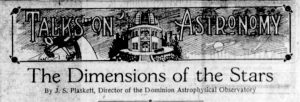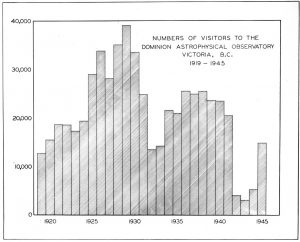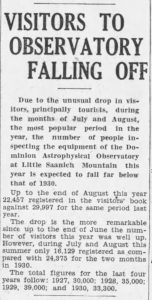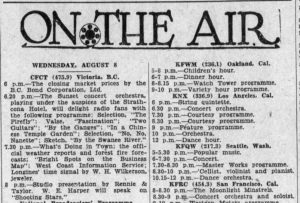An Enduring and Popular Public Relationship
After the Dominion Astrophysical Observatory opened its doors to the public for the first time in June of 1918, the observatory staff, led by Plaskett, began conducting regular outreach programs for Victoria residents. Every Saturday night, the public was invited to view the stars through the observatory’s telescope. In addition, the staff wrote articles for local newspapers and gave public talks to keep the community informed about the latest discoveries and efforts at the observatory.

Bi-weekly “Talks on Astronomy” articles such as this one by J.S. Plaskett, help Observatory staff increase outreach to Victoria residents and inform them of developments in astronomy.
As public interest grew, the staff began writing a biweekly column in the British Daily Colonist newspaper called “Talks on Astronomy”, providing regular updates on progress in astronomy and the observatory’s work. Unfortunately, their outreach efforts were temporarily suspended in 1919 due to the flu pandemic, but they resumed as soon as conditions improved.

This graph shows the number of visitors to the Observatory each year. The numbers climbed during the 1920s peaking in 1929. The numbers declined during the Great Depression and the Second World War.
In the 1920s, the observatory staff made increasingly significant astrophysical discoveries, and public interest continued to grow. The observatory’s peak year for visitors was 1929, with a record-breaking 39,029 people visiting the facility. Visitor numbers commonly peaked during the tourism season, but there was also substantial local interest in the observatory year-round.

The number of the visitors declined with the onset of the Great Depression as the number of tourists to Victoria fell dramatically.
The Great Depression, which started in October of 1929, had a significant effect on tourism. Visits to the observatory initially held steady, but eventually fell dramatically as tourism declined. In 1932, only 12,259 visitors attended the facility, which the observatory staff considered “an index of the depression.”
During this time, the Canadian federal government initiated public works projects to provide work opportunities for local communities. The Dominion Astrophysical Observatory was included in this program, and the road up Observatory Hill was widened and paved to better cope with increasing traffic.

Radio was a relatively new technology in the 1920s and W.E. Harper was quick to use to inform Victoria residents. At the time the radio station was owned by the Centennial Methodist Church.
Despite the reduced activity, the observatory staff continued to engage with the local population in new ways. In 1928, Assistant Director W.E. Harper began participating in monthly radio programs on the local CFCT station. These programs focused on new discoveries in astronomy, news from the observatory, and lessons on astronomy in everyday life. Harper continued to host the radio programs even during the Great Depression and regularly published the transcripts for national distribution.
The observatory was featured in different types of media as a destination for tourists. Local touring companies included it on their routes, the BC Electric Railway advertised it along with the famous Butchart gardens, and it also appeared in a 1936 promotional video called “Victoria: The Sunshine City.”
Enjoy this video with English transcript. Tourist Promotion Film Featuring the Observatory
These efforts were successful, and by 1934, visits to the observatory began to steadily increase. In 1935, the new baseline for annual visitors was just over half of the 1929 record, with 21,608 people attending the facility annually. This figure increased slightly to 23,166 in 1938 before dropping again with the onset of the Second World War.
Despite the construction of larger telescopes elsewhere, the observatory staff and institution maintained a strong relationship with the local community. The popular public profiles of the staff and the observatory built during these years continued to attract public interest for years to come.

